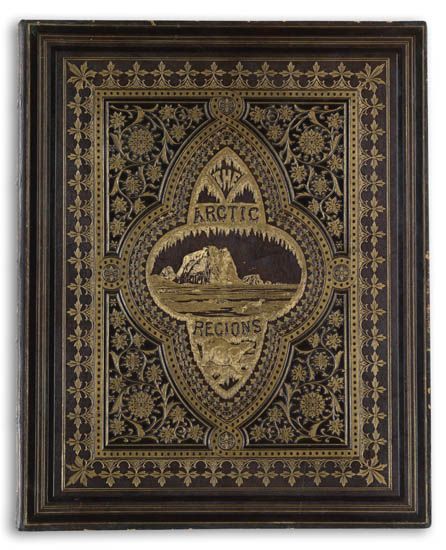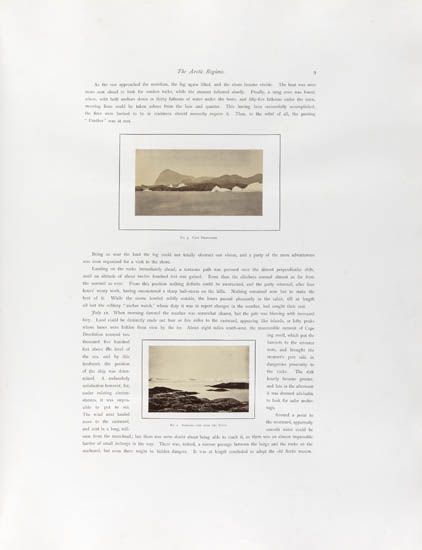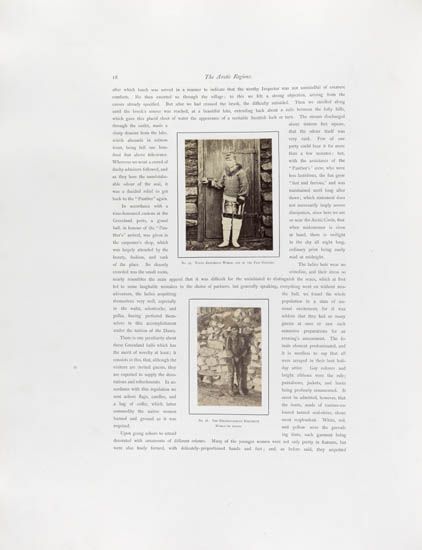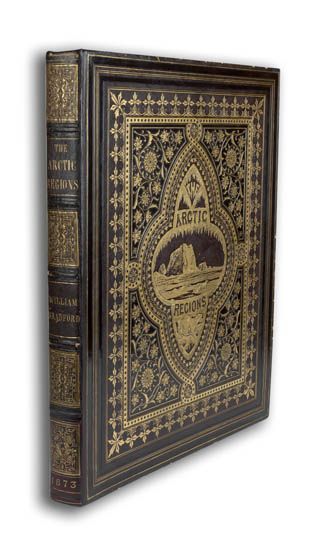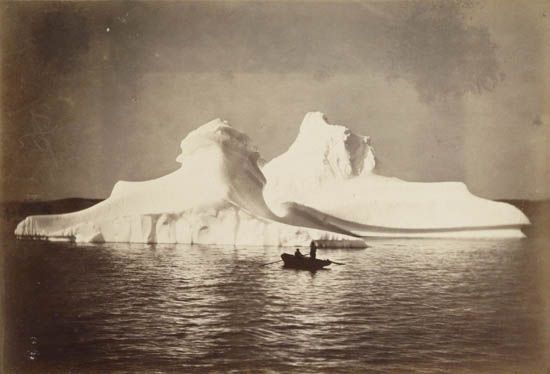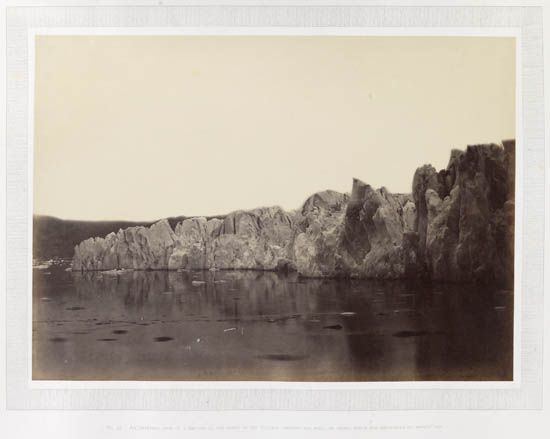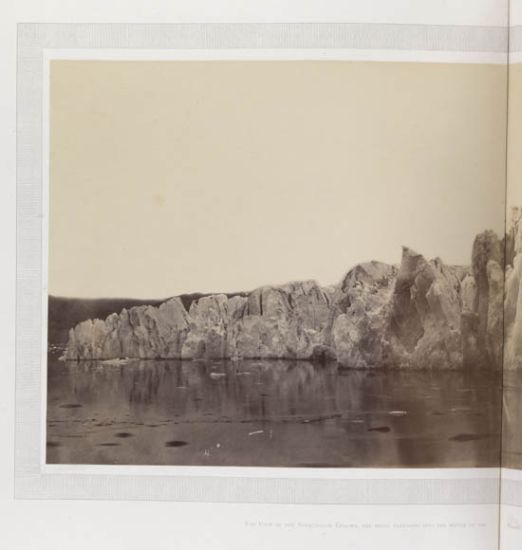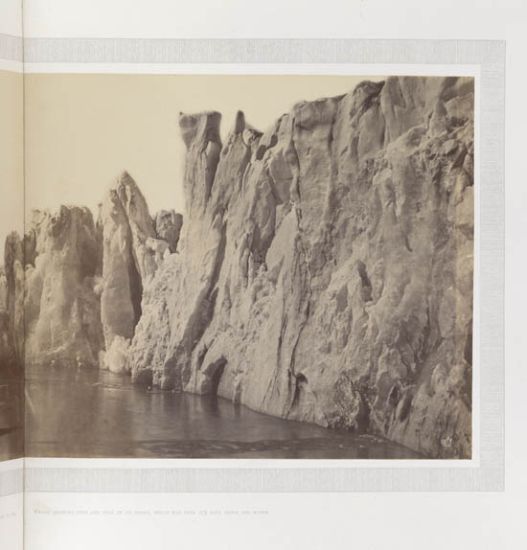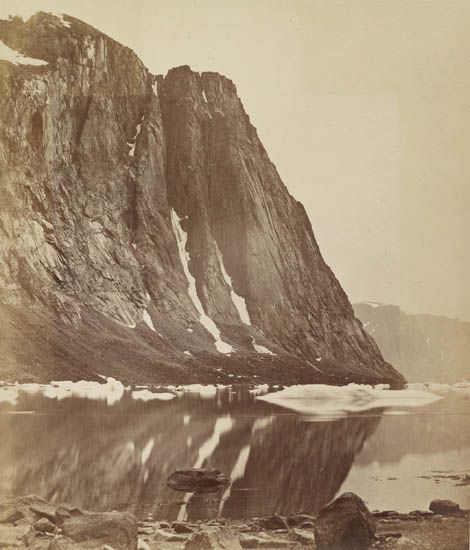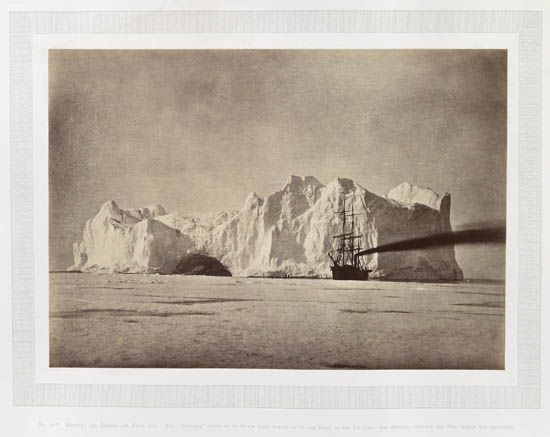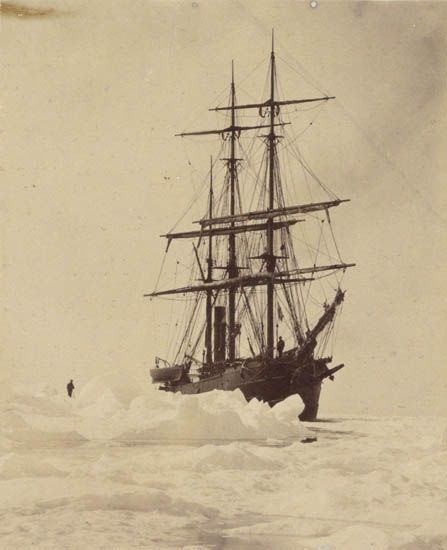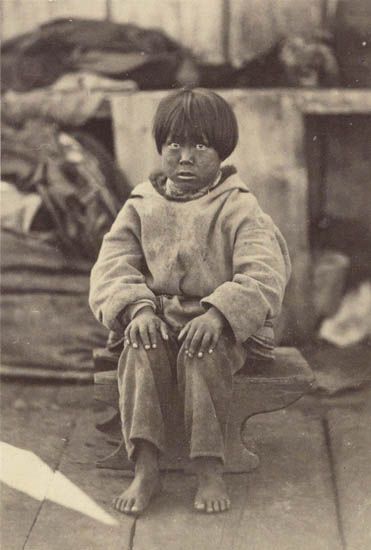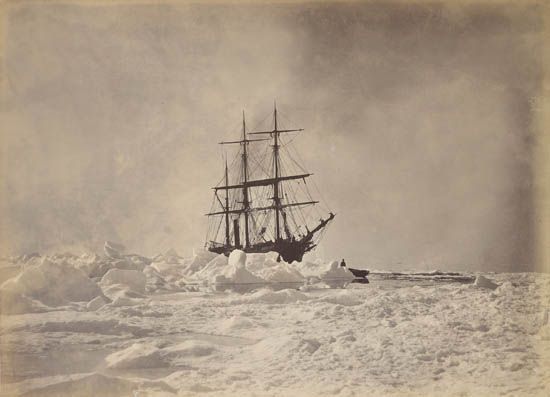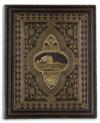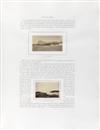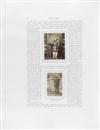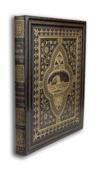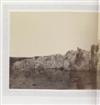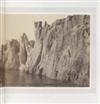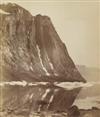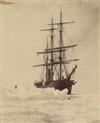Sale 2270 - Lot 12
Price Realized: $ 150,000
Price Realized: $ 180,000
?Final Price Realized includes Buyer’s Premium added to Hammer Price
Estimate: $ 100,000 - $ 150,000
BRADFORD, WILLIAM (1823-1892)
The Arctic Regions, Illustrated with Photographs Taken on an Art Expedition to Greenland.
With a descriptive narrative by Bradford and 141 mounted albumen photographs, from 2 3/4x2 1/4 inches (which are mounted within the text), to 12 1/2x15 1/2 inches (7x5.7 to 31.8x39.4 cm.), mounted one per page, and a double-page panorama measuring 24 1/4x38 1/2 inches (62x97.8 cm.). Folio, 24 1/2x19 1/4 inches (61.6x97.8 cm.), elaborate full gilt-pictorial and gilt-lettered morocco, with a gilded polar bear, seal, and iceberg and floral borders; all edges gilt; internally crisp and clean. from a limited edition of 300 planned copies.
London: Chiswick Press for Sampson Low, Marston, Low and Searle, 1873
The Arctic Regions, Illustrated with Photographs Taken on an Art Expedition to Greenland.
With a descriptive narrative by Bradford and 141 mounted albumen photographs, from 2 3/4x2 1/4 inches (which are mounted within the text), to 12 1/2x15 1/2 inches (7x5.7 to 31.8x39.4 cm.), mounted one per page, and a double-page panorama measuring 24 1/4x38 1/2 inches (62x97.8 cm.). Folio, 24 1/2x19 1/4 inches (61.6x97.8 cm.), elaborate full gilt-pictorial and gilt-lettered morocco, with a gilded polar bear, seal, and iceberg and floral borders; all edges gilt; internally crisp and clean. from a limited edition of 300 planned copies.
London: Chiswick Press for Sampson Low, Marston, Low and Searle, 1873
Additional Details
The Truthful Lens, 24.
Gernsheim Incunabula, S70.
The Photobook: A History (vol. I), 31.
New York Public Library, 258.
From the library of Bruce and Karen Wilburn. This magnificent book was on longterm loan to the New Bedford Whaling Museum, from May to December 2011, and was displayed in the exhibition, 'To The Ends of the Earth: Painting the Polar Landscape,' at the Peabody Essex Museum, Salem MA, from November 2008 to March 2009. The New Bedford Whaling Museum will be mounting an exhibition, in 2013, entitled 'Arctic Regions: Away then Floats the Ice-Island,' in which images will be featured.
William Bradford, a celebrated American artist, was also a traveler and adventurer fascinated with the Arctic landscape. His stunning volume, "The Arctic Regions," the result of six expeditions to the area, is considered a landmark in the history of Arctic exploration, as well as the photographically illustrated book. Sumptuously bound and profusely illustrated with original photographs, it features 141 spectacular albumen photographs, including a 2-part panorama, which set the book apart from other accounts that were illustrated with engravings. The text, which combines sober scientific observation with romantic hyperbole, serves as an invaluable descriptive aid for scientists, adventurers, and environmentalists working today.
Working under Bradford's supervision were John Dunmore and George Crichterson, photographers associated with the prominent Boston-based firm, James Wallace Black Studio. Although they are credited as the official photographers, it is now believed that Bradford himself may have taken many of the pictures, which feature remarkable scenes of icebergs and ice floes in addition to pictures of indigenous people ("Eskimaux") and moored ships.
A source of great interest throughout the nineteenth century, the Arctic captured the public imagination, manifesting itself through a widespread desire for images, stories, and interpretations of this remote and desolate landscape. The images in "The Arctic Region" depict views of an alien, frozen land and its exotic inhabitants. Today, with the debate about climate change, there is a new recognition for the arctic landscape's vulnerability, and how its disappearance will effect coastal regions and islands throughout the world.
In the text, Bradford recounts a voyage in which he worked under adverse conditions. The harsh weather often caused major setbacks, delays, and annoyances among the ship's crew. Dunmore also described a dangerous instance in which their equipment and lives were at stake: "We sailed about sixty miles to the mouth of a glacier, where the icebergs break off, to take some views. Just as we were landing, a large berg broke off which sent the water up twenty feet all over us, and washed away collodion, developing glass, green baize, etc., and came very near taking us along with them." Yet, despite these challenges, they produced remarkable photographs of a stunning, and now endangered, landscape. The volume is a tribute to Bradford's heroic vision and the photographers who skillfully worked in the most difficult of circumstances. Note: JPEGs are available upon request.
A contribution equivalent to the net proceeds of the sale will be donated to the New Bedford Whaling Museum.
Gernsheim Incunabula, S70.
The Photobook: A History (vol. I), 31.
New York Public Library, 258.
From the library of Bruce and Karen Wilburn. This magnificent book was on longterm loan to the New Bedford Whaling Museum, from May to December 2011, and was displayed in the exhibition, 'To The Ends of the Earth: Painting the Polar Landscape,' at the Peabody Essex Museum, Salem MA, from November 2008 to March 2009. The New Bedford Whaling Museum will be mounting an exhibition, in 2013, entitled 'Arctic Regions: Away then Floats the Ice-Island,' in which images will be featured.
William Bradford, a celebrated American artist, was also a traveler and adventurer fascinated with the Arctic landscape. His stunning volume, "The Arctic Regions," the result of six expeditions to the area, is considered a landmark in the history of Arctic exploration, as well as the photographically illustrated book. Sumptuously bound and profusely illustrated with original photographs, it features 141 spectacular albumen photographs, including a 2-part panorama, which set the book apart from other accounts that were illustrated with engravings. The text, which combines sober scientific observation with romantic hyperbole, serves as an invaluable descriptive aid for scientists, adventurers, and environmentalists working today.
Working under Bradford's supervision were John Dunmore and George Crichterson, photographers associated with the prominent Boston-based firm, James Wallace Black Studio. Although they are credited as the official photographers, it is now believed that Bradford himself may have taken many of the pictures, which feature remarkable scenes of icebergs and ice floes in addition to pictures of indigenous people ("Eskimaux") and moored ships.
A source of great interest throughout the nineteenth century, the Arctic captured the public imagination, manifesting itself through a widespread desire for images, stories, and interpretations of this remote and desolate landscape. The images in "The Arctic Region" depict views of an alien, frozen land and its exotic inhabitants. Today, with the debate about climate change, there is a new recognition for the arctic landscape's vulnerability, and how its disappearance will effect coastal regions and islands throughout the world.
In the text, Bradford recounts a voyage in which he worked under adverse conditions. The harsh weather often caused major setbacks, delays, and annoyances among the ship's crew. Dunmore also described a dangerous instance in which their equipment and lives were at stake: "We sailed about sixty miles to the mouth of a glacier, where the icebergs break off, to take some views. Just as we were landing, a large berg broke off which sent the water up twenty feet all over us, and washed away collodion, developing glass, green baize, etc., and came very near taking us along with them." Yet, despite these challenges, they produced remarkable photographs of a stunning, and now endangered, landscape. The volume is a tribute to Bradford's heroic vision and the photographers who skillfully worked in the most difficult of circumstances. Note: JPEGs are available upon request.
A contribution equivalent to the net proceeds of the sale will be donated to the New Bedford Whaling Museum.
Exhibition Hours
Exhibition Hours
Aliquam vulputate ornare congue. Vestibulum maximus, libero in placerat faucibus, risus nisl molestie massa, ut maximus metus lectus vel lorem.



